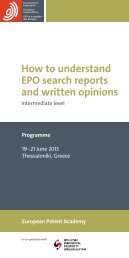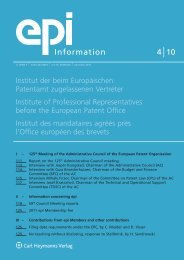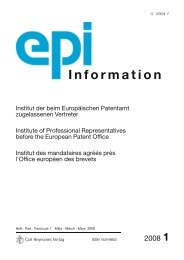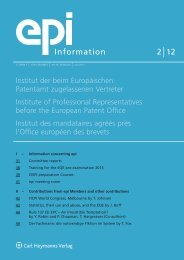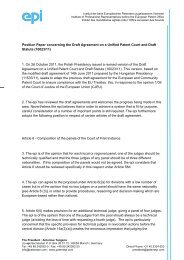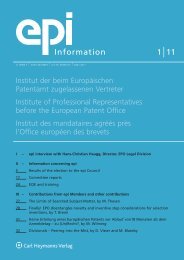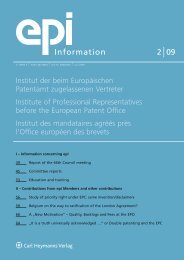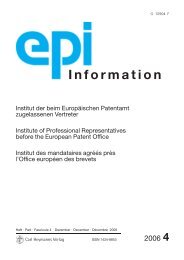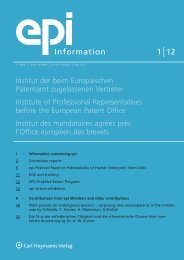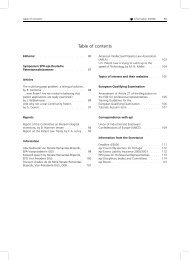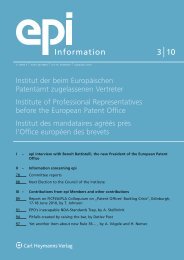epi Position Paper on Patentability of Human Embryonic Stem Cells ...
epi Position Paper on Patentability of Human Embryonic Stem Cells ...
epi Position Paper on Patentability of Human Embryonic Stem Cells ...
Create successful ePaper yourself
Turn your PDF publications into a flip-book with our unique Google optimized e-Paper software.
Institut der beim Europäischen Patentamt zugelassenen Vertreter<br />
Institute <strong>of</strong> Pr<strong>of</strong>essi<strong>on</strong>al Representatives before the European Patent Office<br />
Institut des mandataires agréés près l´Office européen des brevets<br />
<str<strong>on</strong>g>epi</str<strong>on</strong>g> <str<strong>on</strong>g>Positi<strong>on</strong></str<strong>on</strong>g> <str<strong>on</strong>g>Paper</str<strong>on</strong>g> <strong>on</strong> <strong>Patentability</strong> <strong>of</strong> <strong>Human</strong> Embry<strong>on</strong>ic <strong>Stem</strong> <strong>Cells</strong> (hESCs) following<br />
CJEU Decisi<strong>on</strong> C-34/10 (Oliver Brüstle vs. Greenpeace)<br />
Background<br />
This paper sets out the comments <strong>of</strong> the <str<strong>on</strong>g>epi</str<strong>on</strong>g> <strong>on</strong> the policy that the EPO should follow<br />
c<strong>on</strong>cerning the patentability <strong>of</strong> human embry<strong>on</strong>ic stem cells (hESCs). It takes account <strong>of</strong> the<br />
paper CA/PL 6/11 (put forward in November to the Committee <strong>on</strong> Patent Law, CPL) and the<br />
SACEPO Working Party Rules paper SACEPO/WPR 3/12, which is due to be c<strong>on</strong>sidered at<br />
the meeting <strong>on</strong> Friday 3 February 2012.<br />
Legal Basis<br />
The European Patent Organisati<strong>on</strong> decided to incorporate some (but not all) <strong>of</strong> the provisi<strong>on</strong>s<br />
<strong>of</strong> the EU Biotechnology Directive 98/44/EC dated 6 July 1998 into the EPC. In particular,<br />
these were Articles 5 and 6 and Recital 42. They were introduced, inter alia, into new Rule<br />
28(c) EPC.<br />
Article 6 says that inventi<strong>on</strong>s shall be c<strong>on</strong>sidered unpatentable “where the commercial<br />
exploitati<strong>on</strong> would be c<strong>on</strong>trary to ordre public or morality”, which is further clarified (in<br />
paragraph 2c) which states that “uses <strong>of</strong> human embryos for industrial and commercial<br />
purposes” shall be c<strong>on</strong>sidered unpatentable.<br />
Impact <strong>on</strong> EPO practice<br />
The EPO’s policy following this CJEU ruling can <strong>on</strong>ly be decided by the Board <strong>of</strong> Appeal<br />
(BoA). Thus the EPO needs a decisi<strong>on</strong> from the Technical Board <strong>of</strong> Appeal (or the Enlarged<br />
Board <strong>of</strong> Appeal) before it can change its existing practice. The Board <strong>of</strong> Appeal is the<br />
highest decisi<strong>on</strong> making organ within the EPO <strong>on</strong> substantive patent law, and thus legally<br />
speaking <strong>on</strong>ly the Board can decide the impact <strong>of</strong> this CJEU decisi<strong>on</strong>.<br />
Thus <strong>on</strong>ly the Board <strong>of</strong> Appeal can therefore first decide whether (or not, as the case may<br />
be) the EPO is bound by this CJEU ruling (and if it is, in what way), or sec<strong>on</strong>dly how this<br />
decisi<strong>on</strong> should be interpreted by the EPO. Thus there should be no rush to immediately<br />
follow C-34/10 and change the EPO’s practice (assuming that this would be the correct<br />
approach).<br />
The questi<strong>on</strong> therefore arises as to what the EPO’s policy should be in the meantime, before<br />
and until a decisi<strong>on</strong> by the Board <strong>of</strong> Appeal is given. This needs to be carefully c<strong>on</strong>sidered,<br />
because the EPO must not refuse European patent applicati<strong>on</strong>s <strong>on</strong> grounds that might be<br />
criticised or overturned by the Board <strong>of</strong> Appeal. At the current point in time, therefore, the<br />
EPO can therefore <strong>on</strong>ly guess as to what the Board will eventually decide regarding C-34/10.
Institut der beim Europäischen Patentamt zugelassenen Vertreter<br />
Institute <strong>of</strong> Pr<strong>of</strong>essi<strong>on</strong>al Representatives before the European Patent Office<br />
Institut des mandataires agréés près l´Office européen des brevets<br />
The EPO does, though, need to c<strong>on</strong>sider how to deal with this Brüstle decisi<strong>on</strong>, even though<br />
as yet it has no guidance from the Boards <strong>of</strong> Appeal. A cautious approach therefore needs<br />
to be taken, otherwise the EPO could end up refusing patent applicati<strong>on</strong>s <strong>on</strong> grounds which<br />
might later be c<strong>on</strong>sidered by a Board <strong>of</strong> Appeal to be unfounded. Examining Divisi<strong>on</strong>s should<br />
not raise objecti<strong>on</strong>s under Rule 28 that could later be ruled wr<strong>on</strong>g by a BoA.<br />
The EPO is, in effect, entering a new era here. This is the first time that a CJEU decisi<strong>on</strong><br />
arguably affects the EPO’s policy <strong>on</strong> what subject matter is patentable (or not). It is therefore<br />
an unusual situati<strong>on</strong> legally. Furthermore, the issue <strong>of</strong> patentability <strong>of</strong> hESCs is<br />
c<strong>on</strong>troversial, especially as it includes moral and ethical aspects, and needs to be treated<br />
cautiously.<br />
Legal Issues c<strong>on</strong>cerning C-34/10<br />
The EPO, and in particular the Boards <strong>of</strong> Appeal, will first need to decide whether or not the<br />
CJEU decisi<strong>on</strong> is binding <strong>on</strong> the EPO. It is indeed true that the EPC now c<strong>on</strong>tains certain<br />
provisi<strong>on</strong>s <strong>of</strong> the EU Biotechnology Directive. However, it must be remembered that the<br />
EPO is not an EU organisati<strong>on</strong>, as the EPC c<strong>on</strong>tains several n<strong>on</strong>-EU states. Legal opini<strong>on</strong>s,<br />
including those from EU lawyers, c<strong>on</strong>firm this view, namely that the EPO is, in the strictest<br />
sense, not legally bound by the CJEU. Note also that in G2/06 the EPO decided that it did<br />
not have power to refer a questi<strong>on</strong> c<strong>on</strong>cerning interpretati<strong>on</strong> <strong>of</strong> the Biotech Directive to the<br />
CJEU.<br />
If a BoA decides that it is in fact bound by CJEU decisi<strong>on</strong>s, then arguably this will apply to all<br />
CJEU decisi<strong>on</strong>s, and not just C-34/10.<br />
The EPO’s view that it should not grant patents that will clearly be invalid in EU states is<br />
sensible (even though this may be c<strong>on</strong>trary to the EPC). However, that raises the questi<strong>on</strong><br />
<strong>of</strong> what precisely is in fact patentable in various EU member states in view <strong>of</strong> C-34/10. This<br />
has yet to be determined. Indeed, the German court will now have to decide, as a result <strong>of</strong><br />
C-34/10, how that impacts <strong>on</strong> the patentability <strong>of</strong> the inventi<strong>on</strong> by Oliver Brüstle, and it has<br />
not yet made a decisi<strong>on</strong>. The <str<strong>on</strong>g>epi</str<strong>on</strong>g> thinks it would be sensible for the EPO not to “jump the<br />
gun”, and implement a policy <strong>on</strong> patentability <strong>of</strong> hESCs without at least first seeing the<br />
decisi<strong>on</strong> from the German courts and waiting for a decisi<strong>on</strong> from a BoA.<br />
It has to be remembered that, legally, nati<strong>on</strong>al courts <strong>of</strong> the EU member states are <strong>on</strong>ly<br />
c<strong>on</strong>strained to follow CJEU decisi<strong>on</strong>s if the issue under c<strong>on</strong>siderati<strong>on</strong> by that court is “acte<br />
clair”. In other words, if the facts <strong>of</strong> a case are sufficiently different from a CJEU decisi<strong>on</strong>,<br />
then the nati<strong>on</strong>al court may reach a different c<strong>on</strong>clusi<strong>on</strong>. Indeed, in that case a further<br />
referral to the CJEU may even be necessary. For example, the Brustle patent has a<br />
relatively early priority date, <strong>of</strong> 19 December 1997. Courts may take a different view<br />
regarding later EP patent applicati<strong>on</strong>s relating to hESCs, especially if (at the priority date) the<br />
page 2 <strong>of</strong> 5
Institut der beim Europäischen Patentamt zugelassenen Vertreter<br />
Institute <strong>of</strong> Pr<strong>of</strong>essi<strong>on</strong>al Representatives before the European Patent Office<br />
Institut des mandataires agréés près l´Office européen des brevets<br />
inventi<strong>on</strong> could be practiced using a publicly available human ES cell line, without destructi<strong>on</strong><br />
<strong>of</strong> an embryo.<br />
Note that current EPO policy is that if the priority (or filing) date is later than May 2003, when<br />
stem cell lines were publicly available, then Rule 28(c) does not apply, and the inventi<strong>on</strong> is<br />
not c<strong>on</strong>sidered to be immoral under Article 53(a) EPC.<br />
A Board <strong>of</strong> Appeal will also need to decide whether or not C-34/10 is c<strong>on</strong>trary to TRIPS, in<br />
which Article 27(1) states that “patents shall be available for any inventi<strong>on</strong>s, whether<br />
products or processes in all fields <strong>of</strong> technology”.<br />
Interpretati<strong>on</strong> <strong>of</strong> C-34/10 and questi<strong>on</strong> 3<br />
The relevant legal provisi<strong>on</strong> is that inventi<strong>on</strong>s are unpatentable if they relate to “uses <strong>of</strong><br />
human embryos for industrial and commercial purposes”. It was <strong>on</strong> this provisi<strong>on</strong> that the<br />
three questi<strong>on</strong>s were referred to CJEU. The answer to the third questi<strong>on</strong> is perhaps the most<br />
important, where it is stated that an inventi<strong>on</strong> is not patentable where:<br />
“the technical teaching which is subject matter <strong>of</strong> a patent applicati<strong>on</strong> requires the prior<br />
destructi<strong>on</strong> <strong>of</strong> human embryos or their use as base material, whatever the stage at which<br />
that takes place and if the descripti<strong>on</strong> <strong>of</strong> technical teaching claimed does not refer to the use<br />
<strong>of</strong> human embryos”.<br />
This quote is <strong>on</strong>ly <strong>on</strong>e English translati<strong>on</strong> <strong>of</strong> the answer to 3rd questi<strong>on</strong>, which was originally<br />
given in German. The CJEU initially issued a first English translati<strong>on</strong>, which was later<br />
amended. There is therefore some doubt over the exact meaning <strong>of</strong> the answer to questi<strong>on</strong><br />
3 in the German language, let al<strong>on</strong>e exactly what it means in English.<br />
The answer to questi<strong>on</strong> 3 would, at first sight appear to go bey<strong>on</strong>d decisi<strong>on</strong> G2/06. This is<br />
because the EPO’s current practice is to allow cases filed after May 2003 and where reliance<br />
can be made <strong>on</strong> a publicly available stem cell line. The practice <strong>of</strong> the EPO c<strong>on</strong>cerning<br />
deposited stem cells lines flows from the G2/06 decisi<strong>on</strong>, and any policy by the EPO, prior to<br />
a decisi<strong>on</strong> <strong>of</strong> the Boards <strong>of</strong> Appeal, that goes bey<strong>on</strong>d G2/06 is arguably ultra vires. Decisi<strong>on</strong><br />
C-34/10 arguably goes bey<strong>on</strong>d G 2/06, and indeed the EPO’s current policy (with the May<br />
2003 threshold) and so a further BoA decisi<strong>on</strong> is needed to see if this indeed so. Note that G<br />
2/06 <strong>on</strong>ly dealt with the situati<strong>on</strong> where the performance <strong>of</strong> the inventi<strong>on</strong> “necessarily”<br />
involved the destructi<strong>on</strong> <strong>of</strong> a human embryo. This is not the case for many later,<br />
downstream, inventi<strong>on</strong>s.<br />
The law says that what is unpatentable is the commercial exploitati<strong>on</strong> <strong>of</strong> inventi<strong>on</strong>s, not the<br />
making <strong>of</strong> the inventi<strong>on</strong> itself.<br />
page 3 <strong>of</strong> 5
Institut der beim Europäischen Patentamt zugelassenen Vertreter<br />
Institute <strong>of</strong> Pr<strong>of</strong>essi<strong>on</strong>al Representatives before the European Patent Office<br />
Institut des mandataires agréés près l´Office européen des brevets<br />
This is c<strong>on</strong>firmed by paragraph 49 <strong>of</strong> C-34/10, which states that an inventi<strong>on</strong> is regarded as<br />
“unpatentable.....where the implementati<strong>on</strong> <strong>of</strong> the inventi<strong>on</strong> requires destructi<strong>on</strong> <strong>of</strong> human<br />
embryos”. In other words, if the performance <strong>of</strong> the inventi<strong>on</strong> requires destroying human<br />
embryos, then it is unpatentable. That does not, however, mean that an inventi<strong>on</strong> is<br />
unpatentable if at some stage, far upstream and distant from making the inventi<strong>on</strong>, a human<br />
embryo was destroyed. In any event it may not be possible for the EPO (or indeed the<br />
applicant) to be absolutely sure that an embryo was in fact destroyed many years before the<br />
inventi<strong>on</strong> claimed, possibly by a third party and in a different country. Thus the EPO faces a<br />
real practical problem in that it will not be able to clearly check for embryo destructi<strong>on</strong>, and so<br />
apply the law, when the inventi<strong>on</strong> claimed is so far removed and distant from any such<br />
destructi<strong>on</strong>.<br />
The answer to questi<strong>on</strong> 3 refers to the prior destructi<strong>on</strong> <strong>of</strong> human embryos, or their use as<br />
base material, even if the technical teaching claimed does not refer to the use <strong>of</strong> human<br />
embryos. However, it is established and inc<strong>on</strong>trovertible EPO law that the inventi<strong>on</strong> is<br />
defined by the claims, and supported by the descripti<strong>on</strong>. So, as a practical matter, <strong>on</strong>e<br />
cannot ignore the descripti<strong>on</strong>, nor the scope <strong>of</strong> matter that is being claimed. Otherwise, every<br />
EP patent applicati<strong>on</strong>, even <strong>on</strong>es that <strong>on</strong>ly in passing menti<strong>on</strong> hESCs, become unpatentable.<br />
The technical teaching <strong>of</strong> the patent applicati<strong>on</strong> must therefore be c<strong>on</strong>sidered, and cannot,<br />
as a practical matter, just be ignored. If, for example, a technical teaching refers to human<br />
ES cells, as well as other cell types, this must not be used to taint the entire applicati<strong>on</strong> given<br />
that there may be n<strong>on</strong>-ES cell aspects to the inventi<strong>on</strong>.<br />
Thus, the <str<strong>on</strong>g>epi</str<strong>on</strong>g> c<strong>on</strong>siders that, when sensibly interpreted, the C-34/10 cannot render<br />
unpatentable an inventi<strong>on</strong> which clearly does not require the destructi<strong>on</strong> <strong>of</strong> a human embryo.<br />
So, a method <strong>of</strong> producing pluripotent stem cells (iPS), for example by expressing an adult<br />
cell genes that are merely identified by screening human ES cells, should be patentable. In<br />
additi<strong>on</strong>, new culture media or a culture vessels should be patentable, as the inventi<strong>on</strong> will<br />
be applicable to ES as well as n<strong>on</strong>-ES cells. In a similar vein, methods <strong>of</strong> culturing or<br />
preserving cells should not be excluded, even if the claims cover culturing hECSs (as well as<br />
other cell types).<br />
N<strong>on</strong>e <strong>of</strong> these inventi<strong>on</strong>s require the destructi<strong>on</strong> <strong>of</strong> human embryos for its exploitati<strong>on</strong> or<br />
performance, and therefore they must all be patentable.<br />
Commercial Implicati<strong>on</strong>s<br />
<strong>Stem</strong> cell research is an extremely important and growing area <strong>of</strong> science. It is capable <strong>of</strong><br />
huge potential, and shows enormous promise. It may be able to treat patients for diseases<br />
which otherwise do not currently have a cure, such as neurodegenerative disorders such as<br />
ALS and Parkins<strong>on</strong>’s disease. It should be remembered that the EU actually funds research<br />
page 4 <strong>of</strong> 5
Institut der beim Europäischen Patentamt zugelassenen Vertreter<br />
Institute <strong>of</strong> Pr<strong>of</strong>essi<strong>on</strong>al Representatives before the European Patent Office<br />
Institut des mandataires agréés près l´Office européen des brevets<br />
in this area. The EPO’s mandate is to grant patents, and to encourage innovati<strong>on</strong> in EPC<br />
states. It should not therefore deny patent protecti<strong>on</strong> for inventi<strong>on</strong>s arising from scientific<br />
research in this area, at least not until a Board <strong>of</strong> Appeal has decided <strong>on</strong> the impact <strong>of</strong> C-<br />
34/10.<br />
page 5 <strong>of</strong> 5



